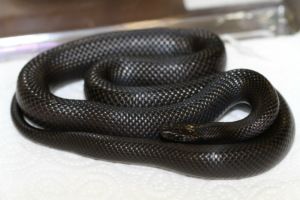News
Nature Round-Up: Watch out for escaped snake in Aarhus!
This article is more than 3 years old.

No, not a discarded snakeskin belt (photo: The Reptilarium/Flickr)
A Mexican black kingsnake (Lampropeltis getula nigrita) is on the loose in Aarhus, according to East Jutland Police.
The snake was last seen on Trillegårdsvej by an employee of Randers Regnskov, a home for tropical animals, but his capture attempt was unsuccessful because he did not have the right equipment.
The authorities have no idea where it has come from, but presume it’s escaped from a private home.
Black and about a metre long
It is black and about a metre in length. According to Randers Regnskov, it does look similar in appearance to the common Danish snake, but it does not have the customary two yellow dots on its neck.
The snake is not dangerous to humans or animals, but you still need to be careful, as it can potentially bite you.
If you see it, call 114 immediately.
Denmark miles away from meeting goals for nature and biodiversity
Biodiversity in Denmark is “historically bad” according to a new IPBES report, which claims there is a major disconnect between politicians and nature. In future, it recommends, the value of nature must be included in political decision-making processes. Denmark is not the only country failing to make a contribution to the EU’s bid to ensure that 30 percent of all land is nature-conserved by 2030, but it is one of the worst culprits. It finished bottom in terms of protected nature areas, and was one of the worst for its quality of habitats. ““Today, only a narrow set of material values is involved, such as the market value of biomass,” contends Professor Mette Termansen from the University of Copenhagen, a major contributor to the IPBES report. “It is about how, for example, the Ministry of Finance can calculate how nature contributes to value in society and how these values can be more involved by decision-makers. A paradigm shift is strictly necessary.”
Wolf has pups near Billund
A pair of wolves living at the Klelund Plantage near Hovborg, south of Billund in Jutland, have given birth to pups. At least one pup born in early May has been observed. This is the fourth time a pair has been observed breeding successfully in the ten years since wolves migrated in 2012. “The wolf has been relatively slow to establish itself in Denmark, even though it has been here for ten years,’ Kent Olsen, the head of science at Naturhistorisk Museum Aarhus, told Jyllands-Posten. In addition to the pair at Klelund Plantage, there are two other breeding wolf couples.
Rare bee sighting
A nature blogger spotted a very rare bee this weekend. Sean Birk Bek Craig’s sighting of the rare tormentil wasp bee (Nomada roberjeotiana) in Rabis Ådal, Central Jutland was the first in 50 years.










































